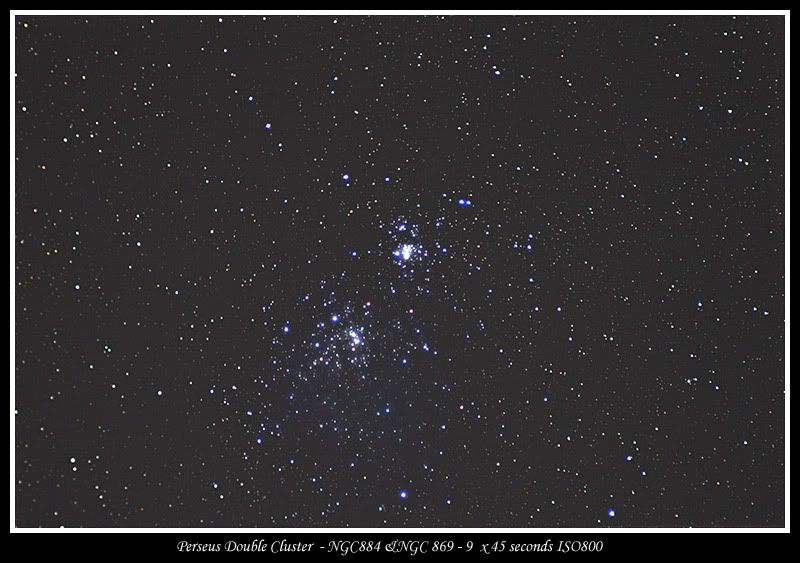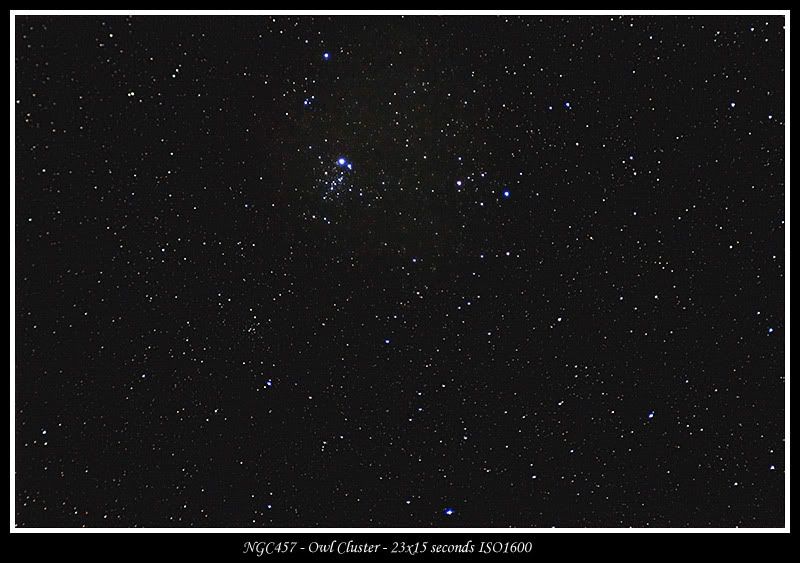A clear night... Ahhh.... The joy of looking up at the wonders of the heavens. Errrmmm, now where was I ? Oh yes, I got the scope out, properly, for the first time in months (June to be precise, although even then I didn't really get to use at as the clouds closed in too fast). Took me a moment to remember the setup... but I got there. So , plonked it down, levelled the legs, powered up. Didn't fall over the US date format (good start), did a skyalign (3 points and the mount works the rest out for you, very easy).
Then I manually slewed the scope to point to the Perseus double cluster. Swapped the diagonal for the 450d, and adjusted the camera settings. Hmm, not so easy. First off to get focus... My first couple of test shots revealed... Nothing. Hmmm.... Then I tried to see through the viewfinder... Nothing. I ran the tube from end to end... nothing. This wasn't going to well. Same with the liveview... still nothing. Then I tried the viewfinder again, and eventually spotted something right on the bottom edge of the view that swam in and out of focus. I used this as a guide, got it about right, and took a test shot, tweaked and shot. This went on for a while, until, with the zoom on the shot review, I got it about right. Phew.
Then I had to work out, how long I could get for an image before trailing occured. This is more difficult using an AltAz mount. But after some playing, I worked out 45 seconds to be about right. I set up my timer remote and hit the go button. In between shots I dashed in and grabbed the 15x70 bins for a look around.
I took in the usual suspects, the Double cluster, Mirfak Association, M31 and a few of the clusters around Cassie. After downloading the shots, it turns out I only had 9 usable frames, not sure why, I need to look at the configuration of the timer remote and camera I think... Anyway, here's the image.
When the camera stopped clicking away, I used the goto to take me to NGC457, the Owl cluster. This took me a while working out the max exposure of 15 seconds... The trailing is much worse, so I set the camera to iso1600, setup the timer and away it went. After downloading, I had 23 frames, and here's the result.
I think they have both come out well, and I'm very pleased. Especially as this is my first go at Prime Focue DSO imaging.
Once this was complete, I decided to try a couple of other NGC's and see what I could get. Unfortunatly for me, the mount decided to go the long way around, and in trying to move the power supply, knocked a leg. I didn't think anything of it at the time, but it had an effect as I'll explain later. Anyway, the first NGC eventually showed up in the FOV I snapped a shot, but couldn't see much. Odd, oh well. I used the goto to slew to M31. This I found ok. But after some experimenting I couldn't get a decent shot without trailling. I took the exposure down to 8 seconds. Damn knocking the leg. Ah well, have to come back another night and try this one again another night.
The moon was beginning to get high in the sky and this presented me with an excellent opportunity for a filter comparison I'd be meaning to do. I powered off and on, a quick solar system align on the moon and I was off.
Over the course of the past couple of months, I've added a couple of Baader CA filters to my collection and now have the following Baader filters.
Fringe Killer (FK), Contrast Booster (CB) and Semi Apo (SA). I thought it would be good to compare them side be side (well one after the other) on my little f5 achro scope. I used the moon as the obvious test subject, and compared both visually and with the 450d at prime focus. Ok, so Visually.
CB - This worked very well and reduced the intensity of the moon nicely, however, the view had a very obvious yellow tint
FK - This also worked very well, didn't have a lot of effect on the intensity and had less of a yellow tint
SA - This worked very well also, but, and this is the most useful difference, the image seen was by far and away the most natural and balanced in terms of colouring.
Here's the images. I manually set the white balacn to Daylight to force the camera to not adjust the captured image automatically.
CB
FK
SA
On the basis of this test, the SA filter is now going to be living in my scope. I hope that's helpful to some of you.
I also took a stack of 20 shots of the moon to have a go at in Registax, but so far this is defeating me. Complaining that the 450d images are too large, then there's not enough space, then a divide by zero. I've not given up on this yet though, and will continue to work on these. Watch this space for the results.
I was awoken at about 0520 this morning by something and took a look out the window. What did I see but the Hunter himself striding purposefully across the skies. An indication that soon there'll be my first views back in the sky. Excellent, I'm looking forward to pointing the camera at them now.
Friday, 19 September 2008
DSO Imaging
Subscribe to:
Post Comments (Atom)







1 comment:
Very Nice
Post a Comment